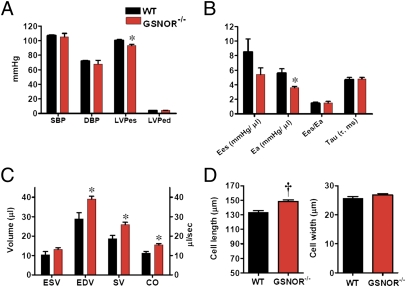Fig. 1.
Integrated hemodynamics reveal reduced vascular tone and increased cardiac output in female GSNOR−/− mice. (A) Systolic (SBP) and diastolic (DBP) blood pressure of GSNOR−/− mice is indistinguishable from WT, although the LV-end systolic pressure (LVPes) is decreased in GSNOR−/− mice, which is a reflection of lower systemic vascular resistance. LVPed, LV-end diastolic pressure. (B) GSNOR−/− mice have reduced afterload. Vascular elastance is markedly reduced (Ea; P < 0.05 vs. WT), a finding consistent with increased vascular NO bioactivity. The coupling of Ees/Ea and myocardial lusitropy (Tau) are similar between the strains. (C) Integrated CV function. GSNOR−/− mice compensate by increasing chamber size (EDV), thereby increasing stroke volume (SV) and cardiac output (CO) (all P < 0.05 vs. WT). End systolic volume (ESV) is similar between strains. (D) Myocyte length is increased in GSNOR−/− mice, consistent with the increased chamber size. *P < 0.05 vs. WT, †P < 0.001 vs. WT, t test.

